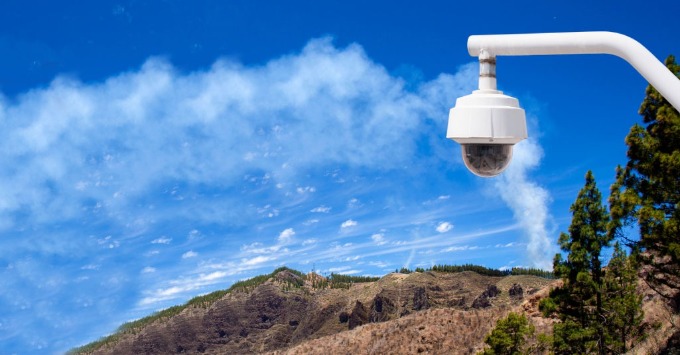
- Finding a solution that could connect to several cameras and sensors to aggregate information and upload information to the cloud for remote analysis, control, and monitoring.
- The Customer needed a rugged IoT gateway that could be deployed outdoors in a NEMA enclosure where it will be subjected to scorching hot temperatures and freezing cold temperatures while providing for reliable and optimal performance 24/7
- The solution needed to be fanless to eliminate the introduction of dust and debris into the system, as well as handle deployment inside a NEMA enclosure without running into thermal issues.
- The Customer required a solution that could reliably connect to the internet in remote environments where reliable wired and Wi-Fi connectivity is not available to offload critical data to the cloud, where AI algorithms will be used to detect and confirm the presence of fires
- The solution had to be compact enough to fit in a small NEMA enclosure while operating reliably and optimally
The Solution
- The RCO-3400 is ruggedly designed and built, enabling it to perform in volatile environments where it will be subjected to dust, debris, shocks, vibrations, and extreme temperatures
- The IoT gateway comes equipped with six GigE RJ45 LAN Ports, allowing organizations to connect up to six cameras/and sensors to the IoT gateway so that data can be collected and relayed to the cloud, where AI algorithms will analyze the data for the purpose of detecting and confirming fires.
- The RCO-3400 is compact enough to fit in a small NEMA enclosure where it can operate reliably and optimally thanks to its fanless design
- The IoT gateway was configured with SSDs, allowing high bit rate data generated from UHD (ultra high definition) cameras to be written to the drive very quickly to ensure that the system does not slow down as the result of a slow storage device
- The RCO-3400 comes equipped with TPM 2.0, which is hardware-based security, securing and encrypting the information on the device to prevent unauthorized access to it.
- The RCO-3400 provides extreme safety, making it an ideal candidate to pass UL certification.
The Benefit
- The rugged and fanless design of the RCO-3400 makes deploying it outdoors in extreme environments possible
- The fanless design eliminates the need for vents and holes, making the system resistant to dust and debris since they have no point of entry into the system.
- The RCO-3400 is equipped with six GigE LAN Ports, allowing the IoT gateway to collect and relay information to the cloud from six sensors and/or ultra HD cameras.
- The compact design of the RCO-3400 enables organizations to deploy the device in small enclosures where size and weight matter.
- DUAL SIM slots allow the system to connect to two wireless carriers for redundant internet connectivity, ideal for systems deployed in remote environments where reliable internet connectivity is not always available.
Introduction
The United States has seen a large increase in the number of wildfires. 2020 was the worst year for wildfires since 1960 as it saw more than 58,000 fires that burned more than 10 million acres. Approximately 40% of the acres burnt were in the State of California. The 2020 fires caused more than $10 billion in damages to public and private property, as well as resulted in the loss of human life. So, The Company took matters into its own hands and built an intelligent platform using C&T's RCO-3400 IoT Gateway that enables The Customer’s AI software to detect fires, confirm them, and disseminate information to responders as quickly as possible in order to stop small fires from becoming raging infernos that burn significantly large patches of land, damaging property and causing the loss of human life.
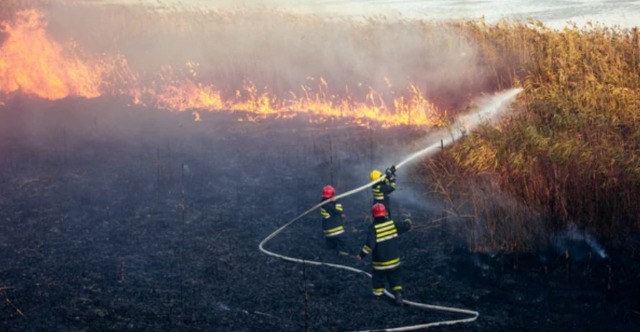
The Challenge
The Customer featured here is a leading provider of an intelligent, AI-powered platform to detect fires, confirm them, and disseminate information to responders faster than ever before. The Customer makes UHD (ultra-high-definition) cameras and purpose-built software to manage its cameras; however, The Customer needed a rugged IoT gateway that could connect to the ultra-high-definition cameras via GigE and upload camera footage to the cloud. Cloud software would then analyze the footage using artificial intelligence (AI) to detect and confirm fires.
Challenge #1
Initially, The Customer inquired about powering the 360⁰ motorized UHD camera via ethernet over PoE+. However, PoE+ (802.3at) was only able to supply a maximum of 25.5 watts of power, which was not sufficient for the camera because it required at least 60 watts of power to operate. Furthermore, PoE+ was not sufficient because the UHD camera captured high-resolution footage and had a motor that needed an external power source to rotate the camera to monitor the environment for fires.
As such, The Customer chose to power the UHD camera from an external power source while requiring RJ45 GigE ports to transmit camera data to the IoT edge gateway, which would then offload the raw camera data to the cloud for analysis.
Challenge #2
Moreover, the second challenge facing the Customer was finding an IoT gateway with multiple GigE ports to connect multiple camera feeds to the IoT gateway to offload the data to the cloud for analysis, remote monitoring, and control.
Challenge #3
The third challenge facing The Customer was finding an IoT gateway that was rugged enough to withstand deployment outdoors in extremely hot and extremely cold environments. The Customer wants to deploy its fire detection system in Northern California, Southern California, and Colorado. In some parts of California, the temperature can exceed 50⁰ Celsius, and in Colorado, the temperatures can go as low as -30⁰ Celsius. As such, The Customer required a proven rugged solution that could withstand deployment in environments that experience extreme temperatures while operating reliably 24/7 to monitor the area in real time for fires.
Challenge #4
Also, the fourth challenge facing The Customer was finding a fanless IoT gateway that could withstand deployment in a NEMA enclosure while providing reliable and optimal performance. This is so because The Customer wanted to deploy the rugged IoT gateway outdoors year-round to monitor remote environments for fires.
NEMA enclosures are great for protecting rugged IoT gateways from water, dust, and dirt; however, they tend to trap heat inside the case, causing the temperatures to exceed levels that are safe for the average desktop computer.
As such, The Customer was searching for a solution that could be deployed inside a NEMA enclosure without running into thermal issues. The challenge included finding a solution where the PC would be passively cooled down without the use of fans. This is so because a fan-cooled PC would simply circulate hot air inside the enclosure, aggravating the thermal conditions inside the enclosure.
Challenge #5
The fifth challenge facing the Customer was finding a rugged IoT gateway that could connect to the internet to offload critical data to the cloud in remote environments without wired or Wi-Fi connectivity. This is so because the IoT gateways and cameras were going to be deployed in remote, forestry environments where Wi-Fi and wired internet connectivity are not available.
As such, the Customer was faced with the challenge of finding a solution that had cellular connectivity, allowing the IoT gateways to transmit UHD camera feeds to the cloud for analysis. Furthermore, The Customer wanted a solution with redundant internet connectivity so that the IoT gateway could continue communicating with the cloud even in the event that one of the carriers was not available. As such, multiple SIM slots were required for redundant cellular connectivity for The Customer’s mission-critical application.
Challenge #6
The sixth challenge the Customer faced was finding a rugged IoT gateway that was compact enough to fit in a small NEMA enclosure. Regular, full-size desktop computers are not capable of fitting into small NEMA enclosures. As such, the Customer was faced with the challenge of finding a small and compact rugged IoT gateway that provided sufficient performance and connectivity options to aggregate camera data and upload it to the cloud while being small enough to fit in a NEMA enclosure.
Challenge #7
The seventh challenge facing the Customer was finding a storage solution that could keep pace with the amount of data that was being collected from the UHD camera. UHD cameras require high-quality storage because UHD cameras tend to have a higher bit rate than standard definition cameras; as such, the storage solutions must be able to cope with the high bitrate for the system to operate at an optimal level. Especially in a decentralized, remote and outdoor IoT application, high-capacity storage options in a rugged IoT gateway were necessary for this deployment.
Challenge #8
The eighth challenge the Customer wanted to overcome was finding a solution that was secure. This is so because the rugged IoT gateways are going to be deployed outdoors, where they will be unmonitored most of the time. As such, the IoT gateway must be secure enough to withstand being tampered with. Thus, TPM 2.0 is required to secure the device from hackers and unauthorized access.
Challenge #9
The ninth challenge The Customer faced was configuring an entire solution (IoT gateway + UHD Camera System) that could pass UL certification. Underwriter Laboratories (UL) is an independent product safety certification organization that tests products to ensure compliance with safety standards. Since C&T's IoT gateways were going to be mounted on electrical poles and cell towers, they had to pass the UL certification standard under the direction and submissions directly from the customers compliance team.
The Solution
The Customer chose to deploy C&T's RCO-3400 Series of rugged IoT gateways to gather data from its UHD (ultra-high-definition) camera and send the data to the cloud for remote monitoring and control.
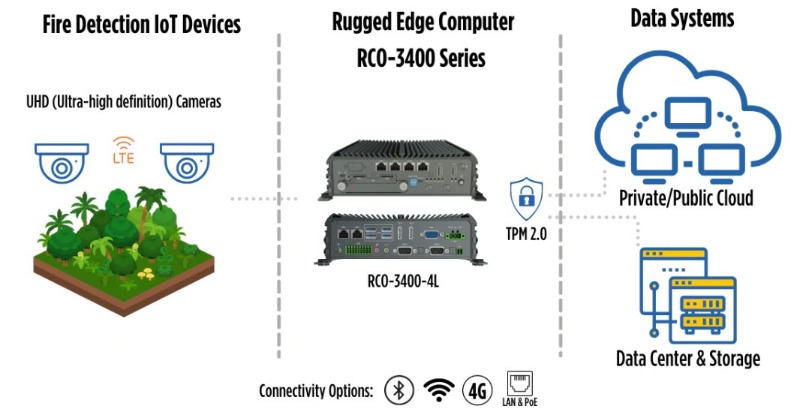
Solution #1
First, The Customer chose to deploy the RCO-3400 because it was ruggedly designed and built, allowing The Customer to deploy the IoT gateway in harsh environments that experience extreme cold and hot temperatures, dust, shocks, and vibrations. The RCO-3400 is capable of withstanding such harsh environments because it employs a fanless design that allows C&T to passively cool the device, eliminating the need for vent holes and opening, which eliminates the ability of dust and debris to enter the system, a perfect solution for deployment in harsh and remote locations.
Furthermore, the fanless design and use of wide temperature range components allows the RCO-3400 to withstand exposure to extreme temperatures. So, whether you’re deploying the RCO-3400 in the middle of the Mojave Desert during the summer, where the temperature reaches 50⁰C or the middle Maybell, Colorado during the winter where the temperature reaches -20⁰C, the RCO-3400 Series of rugged IoT gateways will be able to operate optimally and reliably.

Solution #2
Second, The Customer deployed the RCO-3400 because it could be configured with up to 4 additional GigE ethernet ports, allowing The Customer to connect multiple UHD Cameras and sensors to the Iot gateway for data telemetry, and sending video feeds and sensors data to the cloud where AI algorithms will be used to analyze data in search of possible fire detection in real-time.
Solution #3
Third, The Customer chose the RCO-3400 because of its ability to be deployed outdoors in a small NEMA enclosure. The RCO-3400 fits the bill because it has a fanless design that allows the gateway to cool itself down passively via the use of mechanical heatsinks for passive cooling. Heatsinks transfer heat away from the internal heat-generating components to the outer enclosure of the gateway, which dissipates the heat into the air surrounding the system.
Air cooling was not an option for The Customer use case because the edge IoT gateways were going to be deployed in NEMA enclosures, using fans to cool down the systems would result in very bad thermal management since the fans would continue to recirculate hot air inside the enclosure, causing the edge gateway to thermal throttle or overheat and shutdown, something this mission-critical application cannot afford happening.
As such, The Customer wanted a fanless solution, with an efficient yet low-powered processor, such as the Intel® Core® i3 7100U Dual Core Processor, which has a TDP (thermal design power) of 15 watts, making it ideal for deployment in small enclosures, such as a NEMA 4 enclosure because it uses little power and therefore produces little heat, which is what is required for The Customer’s deployment.
Solution #4
Fourth, The Customer was searching for a solution that could connect to the internet while deployed in remote environments where there is no wired nor Wi-Fi connectivity. The RCO-3400 comes with cellular connectivity via dual SIM slots, allowing the IoT edge gateway to use dual wireless carriers for redundancy. So, in the event that one cellular carrier is not available, the edge gateway can still connect to the internet via a second internet carrier to offload camera and sensor data to the cloud for remote monitoring and control for immediate fire detection.
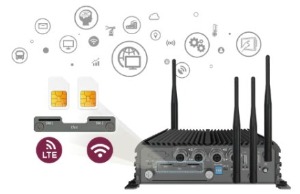
Furthermore, when it comes to connectivity, the RCO-3400 Series comes equipped with four GigE ports for connection to high resolution cameras and sensors that support the standard. Initially, the Customer chose to deploy the RCO-1000 Series of IoT gateways; however, they needed x4 additional GigE RJ45 LAN ports to connect more cameras to the edge gateway, as such they opted to deploy the RCO-3400 because it can be configured with up to six GigE ports, allowing the edge gateway to connect to multiple cameras and sensors.
Solution #5
Fifth, The Customer wanted a solution that was compact enough to fit into a small NEMA enclosure. The RCO-3400 was compact enough for The Customer’s deployment, coming in at 192MM (W) x 197MM (D) x 57MM (H), making it small enough to fit in most small enclosures. To place things into perspective, a regular desktop PC has the following dimensions: 480MM (W) x 230MM (D) x 460MM (H), making the RCO-3400 Series significantly more compact than full-size desktop computers but also providing power-efficient multi-core processing. Furthermore, the RCO-3400 comes with a universal mounting bracket, allowing those deploying it to easily and quickly mount the device to walls, ceilings, and other surfaces.
Solution #6
Sixth, The Customer required a solution that could cope with the velocity and volume of data that was produced by the UHD (ultra-high-definition) cameras that are being used to monitor the environment for smoke and fires. UHD cameras tend to have a higher bitrate than regular standard definition cameras, and so the storage solution must be able to write data very fast to the device. As such, The Customer configured the RCO-3400 with SSDs (solid-state drives), which can read and write data at speeds that are significantly faster than traditional hard drives (HDDs), eliminating the possibility that the storage solution bottlenecks the system.
Solution #7
Seventh, The Customer wanted a secure computing solution. When it comes to security, rugged IoT gateways come equipped with TPM 2.0 (trusted platform module). TPM 2.0 is a cryptoprocessor that is integrated into the hardware of an IoT gateway to secure the data that’s on the device. Hardware security provides better protection than software security alone, protecting IoT gateways from hackers and malicious software.
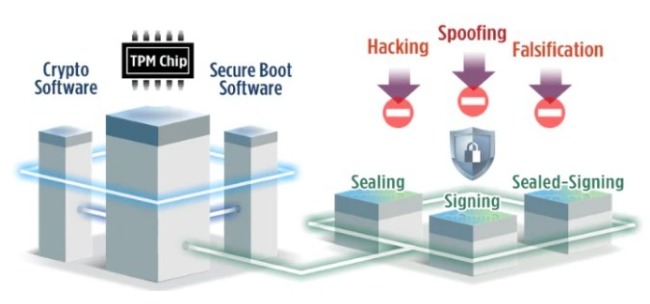
Solution #8
Finally, The Customer requires a safe system since the platform will be attached to utility poles and other sensitive locations that require electronics that are deployed to have a UL certification. As such, The Customer chose to deploy the RCO-3400 Series of rugged IoT gateways for easy UL certification.
The Benefits
By combining an efficient yet low powered processor with multiple GigE Ethernet ports in a rugged enclosure, C&T's RCO-3400 was more than capable of aggregating and communicating data received from UHD cameras to the cloud, where AI algorithms will be used on the data to detect and confirm fires.
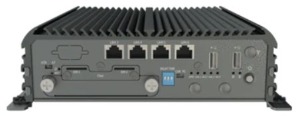
Product Focus Benefits For Deploying RCO-3400
- The rugged and fanless design of the RCO-3400 permits it to be deployed outdoors in extreme environments that experience freezing cold and scorching hot temperatures while operating optimally and reliably 24/7.
- The fanless design of rugged mini PCs enables the outdoor deployment of rugged IoT gateways because there are no vents or holes through which dust can enter the system, causing damage to the sensitive internal components.
- The RCO-3400 can be expanded to include up to six GigE RJ45 LAN ports, allowing organizations to connect up to six devices/cameras to the IoT gateway.
- The RCO-3400 has a compact design, giving the device a small footprint, allowing it to be installed in small NEMA enclosures for easy mounting to utility poles and cell towers.
- The RCO-3400 can be configured with dual SIM Slots, permitting organizations to install two wireless carriers for redundancy. For example, if one wireless carrier is not available, the IoT gateway can connect to the internet via a secondary wireless carrier to offload critical data to the cloud.
- TPM 2.0 is hardware-based security that protects the data on IoT gateways from unauthorized access and hackers.


